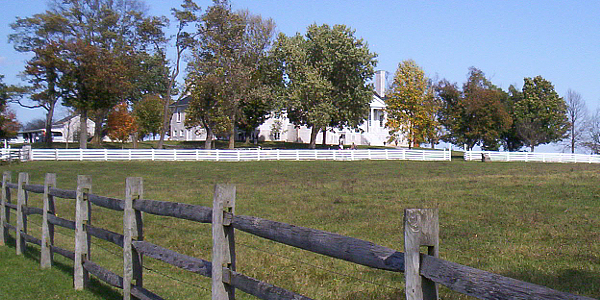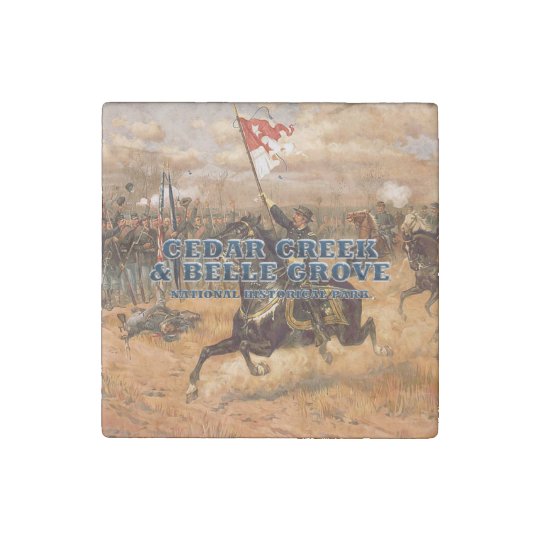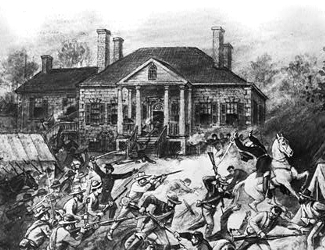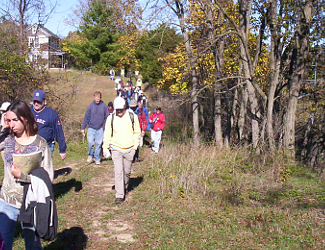
Union General Phil Sheridan's ride on horse Rienzi to rally his troops in the Battle of Cedar Creek. Courtesy Library of Congress. Living History and reenactors in front of the Heater House on the Cedar Creek battlefield.

Cedar Creek and Belle Grove NHP
The Civil War in 1864 was undergoing a significant shift andthat shift was taking place in three predominant regions of the eastern theater. Ulysses S. Grant, new head of the army in the east, wanted action, and he directed three generals to make that plan work. We know more about the first two; General Meade with Grant in tow fighting large battles from the Wilderness to Spotsylvania to Richmond and Peterburg, Sherman marching through Atlanta to the sea, and the third,the Shenandoah Valley Campaign that kept Jubal Early and the Confederates from capturing Washington while the others did their deeds.
Click here to Sponsor the page and how to reserve your ad.

Cedar Creek Then
The Battle of Cedar Creek was the last of the Shenandoah Valley conflicts; it was its ultimate end, from a significant perspective, and would end the Confederate surge from that third of the 1864 landscape. But, boy, it wasn't easy for the Union. And boy, it made heros of two men, Phil Sheridan, and George Armstrong Custer, although that man Custer sure tried to get rid of that tag once the Civil War was done.
Belle Grove Plantation - Prior to war coming to the Shenandoah Valley, the Belle Grove plantation was built in 1797 with 483 acres of land surrounding it. It's history reaches back to a 140,000 acre land grant and touches President James Madision through his sister Nelly. Once war raged nearby, it became an eventual Union headquarters of General Phil Sheridan as he checked Confederate General Jubal Early.
After the successful victory by the Union at Winchester, north of Middletown, Sheridan established his camp on the grounds surrounding here, and thinking, for the most part, that the Winchester victory was the final one of the year, he went to Washington, D.C. for meetings. But the Confederates had other plans, waging a flank attack with inferior numbers (they were outnumbered 12,000 to 32,000) that won the morning, overtook the Belle Grove mansion, and forced the Union through town to the north. But the afternoon was a very different story. Phil Sheridan heard of the battle and trouble at Cedar Creek, and rode his horse Rienzi in a mad dash twelve miles to rally his troops (painting at top of page). And that is what he did. Along with two successful cavalry battles on his right (Custer) and left (Merritt), the counterattack won the day, pushing Early's forces south, past the mansion and all the way to the Shenandoah Mountains. This would effectively end the Confederates ability to wage siginificant war in the Valley and allow Grant to focus on Petersburg and Richmond through the fall of 1864 and into the spring of 1865.
Photo above: Lithograph of the Battle of Cedar Creek, 1890, Kurz and Allison. Courtesy Library of Congress. Below: Fence row leading to the Belle Grove Plantation Mansion.

Cedar Creek Now
Perhaps the most unique part of this battle and its aftermath comes in the somewhat new national park that now stretches for 1,700 acres across the Middletown landscape. The park has been in existence for barely fifteen years, depending when you count existence (Congress passed its legislation in 2002), but it's been less than that in practicality. How new is it? The main visitor center for the National Park Service is still in a strip mall, and it's only been there since 2013. But don't let that fool you or keep you from its doors. The visitor center is compact, but nice. Full of information about tours, exhibits, and electric map style display that really tells the battle story well, and more.
This is ground floor national park service stuff and it's well-interpreted and moving full force toward placing additional signs and access to the various parts of the park. It is a partner style park, with various organizations taking their full part in telling the story about the battle and region. Belle Grove Plantation, one of the highlights, is a fully restored limestone home and museum which served as Union headquarters, and is run by the Belle Grove Foundation. Another foundation is the Cedar Creek Battlefield Foundation, which runs the Cedar Creek Foundation Headquarters (a visitor center, museum, and bookstore) plus the Hupp's Hill Civil War Park south of town. There are more partners, too, which are contributing land, services, and more. How involved are the partners? Of the 1,700 plus acres now preserved for the park, the National Park Service only owns 80, and the Civil War Trust, now the American Battlefield Foundation, owns additional ground.
The park interprets that battle with a series of walks, talks, and rides that takes you across the breadth of the park. Meanwhile, it's partners at Belle Grove plantation takes you into the refined confines of a limestone manor and contrasts the brutal battle that took place on it's grounds and the grounds of its neighbors. One of those neighbors, just to their north, was the Heater family. (Heater family home photo below). The Heater family was one of divided loyalty. A mother staunchly Union from the state of Pennsylvania; a husband and sons (they fought for the south) with other ideas. Ask the ranger about this story, or any of the myriad of others that are told at the park. You'll be on that ground floor of a chance to tell history that's over 150 years old now.
T-Shirts and Souvenirs

Cedar Creek and Belle Grove T-Shirts and Souvenirs from the official merchandise of America's Best History.

Cedar Creek
Things You Should Not Miss
1. Visit the NPS Contact Center. Best place to orient yourself to the battle with the electric map display as well as to have the park rangers there tell you about the partners and their tours. There is a self-guided auto tour (free) and cell phone tours available to purchase at various locations.
2. Take in a ranger tour. There are two we would particularly like to suggest. One is a car caravan tour of two hours that goes to various locations around the park. The other, on different topics, is a Sunset Walk offered on seasonal Friday evenings. But any of the walks and talks of this special Park Service staff are interesting and essential to your understanding of the battle. They're great! One of the special tours we especially liked was the Sheridan ride tour all the way from Winchester. That was the first time offered, not sure if they followed it up with another.
3. Visit Belle Grove Plantation. This is a partner site and well worth the visit and cost. You can learn the stories of the folks who lived there, see a stately mansion, then imagine how the war changed everything.
4. This is off topic a bit, but since it's right down and across thestreet from the Visitor Contact Station and on your way to Belle Grove or a tour, take a second to stop by the Wayside Inn. Known as the Larrick Inn at the time, it's the oldest continuous hotel in America. Maybe you'd even like to stay there or take in a meal at their historic restaurant.
Photo above: Drawing of the Battle of Cedar Creek as it was waged in front of Belle Grove. Courtesy Library of Congress.
Minute Walk in History
160th Anniversary, Morning Confederate Attack
Tour with us over the ground of the surprise morning attack by Confederate General Jubal Early during the 160th Anniversary of the Battle of Cedar Creek on October 19, 1864. During the morning Confederate Attack at 5 a.m., the man of the Union, not expecting an attack, were still in their tents, perhaps making breakfast, and were until 10:30 a.m., routed from the field until General Early decided to stop above town, now known as the Fatal Halt. General Sheridan, commanding the Union Army, was in Winchester after meeting with President Lincoln. He would arrive later in the day.
Minute Walk in History
160th Anniversary, Afternoon Union Counterattack
It had started out as a surprise attack by the Confederates, but as General Sheridan, who had spent the night at Winchester after visiting President Lincoln in Washington, the sounds of battle roared to his south and his Sheridan's Ride on horse Rienzi galloped to rally his troops. Take a ranger guided 160th Anniversary tour and talk about the Union counterattack, which thrust the Shenandoah Valley Confederates under General Jubal Early back across Cedar Creek, never to be an effective fighting force again.





